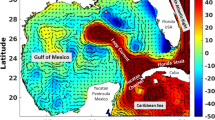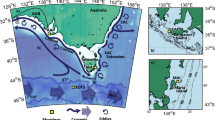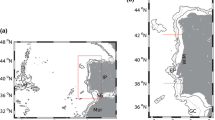Abstract
Movement of seasonal eddies in the Bay of Bengal (BOB) and its relation with cyclonic heat potential (CHP) and cyclogenesis points have been investigated in this study using 6 years (2002–2007) of global ocean monthly analysis datasets based on the Simple Ocean Data Assimilation (SODA) package (SODA v2.0.4) of Carton et al. (2005) and Indian Meteorological Department cyclogenesis points. The region dominated by anticyclonic eddies with CHP greater than 70 × 107 J/m2 as well as good correlations (>0.9) with sea surface height (SSH) and 26°C isothermal depth (D 26) can be a potential region of cyclogenesis. The region dominated by cyclonic eddies with CHP greater than 50 × 107 J/m2 and good correlation (>0.9) with both SSH and D 26 can serve as a potential region of high-level depression. Potential cyclogenesis regions are the southern BOB (5°N–12°N) for the post-monsoon season and the head of BOB (north of 15°N) during southwest monsoon. Seven potential regions are identified for the eddy formation for different seasons, which are consistent with the cyclogenesis points. The CHP distributions alone are able to explain the cyclone tracks for the pre-monsoon and post-monsoon seasons but not for the monsoon season.











Similar content being viewed by others
References
Ali MM, Jagadish PSV, Jain S (2007) Effect of eddies on Bay of Bengal cyclone intensity. EOS Trans AGU 88. doi:10.1029/2007EO08001
Babu MT, Sarma YVB, Murty VSN, Vethamony P (2003) On the circulation in the Bay of Bengal during Northern spring inter-monsoon (March–April 1987). Deep-Sea Res II(50):855–865
Bao JW, Wilczak JM, Choi JK, Kantha LH (2000) Numerical simulations of air-sea interaction under high wind conditions using a coupled model: a study of hurricane development. Mon Wea Rev 128:2190–2210
Carton JA, Giese BS, Grodsky SA (2005) Sea level rise and the warming of the oceans in the SODA ocean reanalysis. J Geophys Res 110. doi:10.1029/2004JC002817
DeMaria M, Michelle M, Shay LK, Knaff JA, Kaplan J (2005) Further improvement to the statistical hurricane intensity prediction scheme (SHIPS). Weather Forecast 20:531–543
Dube SK, Rao AD, Murty TS (2009) Storm surge modeling for the Bay of Bengal and Arabian Sea. Nat Hazards 51:3–27
Emanuel KA, DesAutels C, Holloway C, Korty R (2004) Environmental control of tropical cyclone intensity. J Atmos Sci 61:843–858
Fofonoff P, Millard RC Jr (1983) Algorithms for computation of fundamental properties of seawater. UNESCO Tech Mar Sci 44:53
Fritz HM, Blount CD, Thwin S, Kyaw M, Chan N (2009) Cyclone Nargis storm surge in Myanmar. Nat Geosci 2:448–449
Ginis I (1995) Ocean response to tropical cyclone. In: Elsberry RL (ed) Global perspective on tropical cyclones. WMO/TD-no. 693, World Meteorological Organization, Geneva, pp 198–216
Goni GJ, Trinanes JA (2003) Ocean thermal structure monitoring could aid in the intensity forecast of tropical cyclones. EOS Trans AGU 84(51):573 577–578
Gray WM (1968) Global view of the origin of tropical disturbances and storms. Mon Weather Rev 96:669–700
Henderson-Sellers A, Zhang H, Berz G, Emanuel K, Gray W, Land Sea C, Holland G, Lighthill J, Shieh S-L, Webster P (1998) Tropical cyclones and global climate change: a post IPCC assessment. Bull Am Meteorol Soc 79:19–38
Holliday CR, Thompson AH (1979) Climatological characteristics of rapid intensifying typhoons. Mon Wea Rev 107:1022–1034
Hong W, Chang SW, Raman S, Shay LK, Hodur R (2000) The interaction between hurricane Opal (1995) and a warm core ring in the Gulf of Mexico. Mon Wea Rev 128:1347–1365
Kotal SD, Bhowmik RSK, Kundu PK (2008) Application of statistical-dynamical scheme for real time forecasting of the Bay of Bengal very severe cyclonic storm “sidr” of November 2007. Geofizika 25:139–150
Kumar B, Sil S, Chakraborty A, Pandey PC, Chakraborty A (2010) Seasonal and monthly variation of vertical structure of temperature, salinity and heat flux of the Bay of Bengal. Mar Geod 33(1):76–99
Lin II, Wu CC, Emanuel KA, Lee IH, Wu CR, Pun IF (2005) The interaction of supertyphoon Maemi (2003) with a warm ocean eddy. Mon Wea Rev 133:2635–2649
Lin II, Chen CH, Pun IF, Liu WT, Wu CC (2009) Warm ocean anomaly, air sea fluxes and the rapid intensification of tropical cyclone Nargis, 2008. Geophys Res Lett 36:LO3817. doi:10.1029/2008GLO35185
Paul S, Chakraborty A, Pandey PC, Basu S, Satsangi SK, Ravichandran M (2009) Numerical simulation of Bay of Bengal circulation features from ocean general circulation model. Mar Geod 32:1–18
Sadhuram Y, Rao BP, Rao DP, Shastri PNM, Subrahmanyam MV (2004) Seasonal variability of cyclone heat potential in the Bay of Bengal. Natural Haz 32:191–209
Sarma YVB, Murthy VSN, Rao DP (1990) Distribution of cyclone heat potential in the Bay of Bengal. Indian J Mar Sci 19:102–106
Senguptha D, Bharath Raj G, Anitha GS (2007) Cyclone induced mixing does not cool SST in the post monsoon north Bay of Bengal. Atmos Sci Lett 9:1–6
Shay LK, Goni GJ, Black PG (2000) Effect of warm core ring on Hurricane Opal. Mon Weather Rev 128:1366–1383
Shetye SR, Gouvela AD, Shenoi SSC, Sundar D, Michaeland GS, Nampoothiri G (1993) The western boundary current of the seasonal subtropical gyre in the Bay of Bengal. J Geophys Res 98(C1):945–954
Wada A (2009) Idealised numerical experiments associated with the intensity and the rapid intensification of stationary tropical cyclone-vortex and it’s relation to initial sea surface temperature and vortex induced sea surface cooling. J Geophys Res (Oceans) 114:8111. doi:10.1029/2009
Wada A, Usui N (2007) Importance of tropical cyclone heat potential for tropical cyclone intensity and intensification in the western North Pacific. J Oceanogr 63:427–447
Webster PJ (2008) Myanmar’s deadly daffodil. Nat Geosci 1:488–490
Whitaker WD (1967) Quantitative determination of heat transfer from sea to air during passage of hurricane Betsy. M.Sc. Thesis, Texas A & M University, USA
Acknowledgments
The first author gratefully acknowledges the financial support from the Council of Scientific and Industrial Research (CSIR) to complete the work. This study is also supported by the INDOMOD research project (POM, RP2007) of INCOIS under the Ministry of Earth Sciences, Government of India, and the MOP-2 Program (CCM, RP2008) sponsored by SAC, ISRO. The cyclogenesis points derived from Cyclone e-Atlas of IMD are greatly acknowledged. We are thankful to the CORAL head for academic facilities and support. We are grateful to emeritus Professor P. C. Pandey for his encouragement and scientific discussions. We are also grateful to the anonymous reviewers for their valuable comments and suggestions which help to improve the manuscript.
Author information
Authors and Affiliations
Corresponding author
Rights and permissions
About this article
Cite this article
Kumar, B., Chakraborty, A. Movement of seasonal eddies and its relation with cyclonic heat potential and cyclogenesis points in the Bay of Bengal. Nat Hazards 59, 1671–1689 (2011). https://doi.org/10.1007/s11069-011-9858-9
Received:
Accepted:
Published:
Issue Date:
DOI: https://doi.org/10.1007/s11069-011-9858-9




